| |
|

AJC PERSPECTIVES
Constraints on Israel deciding to retaliate in Gaza range from the legal to the strategic
By Eran Lerman
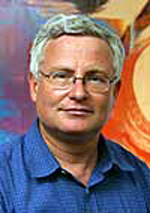 JERUSALEM—Why is it that Israel—militarily far superior, despite the jihadist bravado of its enemies—has taken so long to come to the point of decision about Gaza? And why is military action still delayed, in the face of three Israelis dead in the kibbutzim near Gaza in as many weeks, and a steady barrage of rockets and mortar shells on the western Negev? True, there have been loud warnings in recent days, emanating from Prime Minister Ehud Olmert and members of his cabinet, about an impending operation, but these seem to have been devices, designed—even if one discounts the less charitable suggestion of an internal political dynamic—to frighten and sway Hamas and the Egyptians, in the crucial last stages of a delicate negotiation of a “cease-fire,” conducted in Cairo by the head of the political-military staff of the Ministry of Defense, Major General (res.) Amos Gil’ad, whose messages are conveyed to the Hamas leadership by the head of Egyptian intelligence, General Omar Suleiman. JERUSALEM—Why is it that Israel—militarily far superior, despite the jihadist bravado of its enemies—has taken so long to come to the point of decision about Gaza? And why is military action still delayed, in the face of three Israelis dead in the kibbutzim near Gaza in as many weeks, and a steady barrage of rockets and mortar shells on the western Negev? True, there have been loud warnings in recent days, emanating from Prime Minister Ehud Olmert and members of his cabinet, about an impending operation, but these seem to have been devices, designed—even if one discounts the less charitable suggestion of an internal political dynamic—to frighten and sway Hamas and the Egyptians, in the crucial last stages of a delicate negotiation of a “cease-fire,” conducted in Cairo by the head of the political-military staff of the Ministry of Defense, Major General (res.) Amos Gil’ad, whose messages are conveyed to the Hamas leadership by the head of Egyptian intelligence, General Omar Suleiman.
It is yet to be seen if this tactic has worked, and whether the government, if the talks do fail, will indeed feel obliged to sustain Israel’s credible deterrence by carrying out the threat of a large-scale action. For the time being—and these notes are being written even as the Cabinet debate rages, and some voices close to Olmert, such as his deputy, Haim Ramon, argue for an invasion that would crush the Hamas government in Gaza—the less warlike option is (as often happens in Israel) the stated preference of the Ministry of Defense and the IDF high command, which seems likely to prevail.
What drives this preference of Defense Minister Ehud Barak, never a timid man (he is Israel’s most decorated soldier) for an indirectly negotiated agreement establishing a period of “tahdi’ah” (Arabic for “calm,” a term devoid of any political connotation that could imply Hamas recognition of our right to exist)? To understand the constraints, which hampered even Ariel Sharon in his time—he promised that a terrible reaction would follow, once we withdrew from Gaza, if “a single shot is fired,” but, in fact, did little to respond, once the Qassam rockets began to rain on Sderot—it is necessary to look at a variety of factors: legal, humanitarian, and political, as well as military, diplomatic, and strategic.
In legal terms, the government’s own lawyers have been telling the decision-makers—in this day and age of legal intrusions into literally anything and everything—that, despite the Disengagement, bitter as it was, in 2005, Gaza is still in a sort of limbo. Thus, Israel is not entirely free to act as if Gaza were a neighboring enemy state (which it is, de facto—but not de jure). It is this sort of intrusion that helped ignite the bitter fight between Olmert, Ramon, and Minister of Justice Daniel Friedman, on the one hand, and much of the Israeli legal community, on the other, but it remains a valid aspect of all considerations regarding the future of Gaza.
In the humanitarian realm, there are several considerations weighing against large-scale action: the expected toll in terms of civilian lives lost and of destruction and suffering in Gaza, as battles would be fought in one of the world’s most densely populated areas; the responsibility that would devolve upon the Israeli authorities to provide for this needy, yet hostile, population; and in a far more specific sense, the fate of our abducted soldier Gil’ad Shalit, whose plight was described in his own bitter words in a letter passed on to his family. (At this delicate moment, it is difficult to avoid the thought that the Carter Center, while offering a service, was also knowingly used by Hamas to add this complication to the Cabinet’s calculus.)
In political terms, not only Shalit’s case, which resonates in every home in Israel, but the more general question of the cost of battle raises severe challenges. Hamas forces in Gaza have been trying to model themselves after Hezbollah—increasingly functioning as a regular army, with large-scale formations and orderly lines of command. This would not be a repeat of the limited raids of recent months, or even of the extensive operations in the West Bank— “Operation Defensive Shield”—in April 2002. Once the losses begin to rise, there will be questions asked, and fingers wagged at a prime minister already tainted by scandal.
These worries could be alleviated if a coherent exit strategy were at hand; but in military terms, it is easier (even if costly) to take the Gaza Strip than to hold it. The idea of a prolonged and bloody stay, followed (as in Lebanon now) with the reestablishment of Hamas as victorious rulers, is troubling; whereas the notion of handing over Gaza to Mahmoud Abbas verges, frankly, on the ridiculous: As things stand now, even in Ramallah, his power holds sway only insofar as it is backed by a steady IDF presence.
Diplomatically, the overriding consideration for Israeli decision-makers in general, and the Ministry of Defense in particular, is to avoid a direct confrontation with Egypt. It may be a sad comment on the shortening shadow of Israel—and the U.S.—in regional affairs that Cairo concluded, after the war of 2006, that it was safer to bet on some sort of coexistence with Hamas (abhorrent as this branch of the Muslim Brotherhood may be from the perspective of the Egyptian regime) than on a sweeping and effective Israeli victory. Therefore, the firm position of Egypt now is that a tahdi’ah is a better idea than the military alternative; and a repudiation of their views might come at a cost. There is, however, a corollary demand that Israel poses—and that the U.S., in particular Congress, should firmly underline: namely, that a period of calm makes sense only if it is not used by Hamas to run huge amounts of Iranian-supplied arms into Gaza. It is up to the Egyptian authorities to prevent this from happening—which would require a degree of focused interest and commitment that has yet to be seen along the Gaza border.
Finally, in strategic terms, the decision on Gaza—and almost all other decisions in Israel at this time—must be subordinated to the one overarching issue, which is and shall remain Iran: its nuclear ambitions, its rise to regional dominance, and its leadership’s exterminatory designs toward Israel. Actions that may, even theoretically, serve to weaken Iran’s hold—including the ongoing negotiations with the PA and with Syria—appeal to the inner circle as well as to the people at large, insofar as they flow from this first priority; actions that might play into Iran’s hands raise doubts. When Shaul Mofaz raised the prospect of military action against Iran—rattling the world oil markets—he may have done so because this resonates with an anxious public, but this resonance, in itself, is now a fact of life. The ultimate measure of the utility of action in Gaza must be weighed against the broader dynamics of the struggle to mobilize the international community against Iran in the crucial period ahead. A check on Iran’s ambitions, on what President Mahmoud Ahmadinejad describes as the triumph of their revolutionary will, can quickly change the trend lines on all six issues listed here; without it, an operation in Gaza runs the risk of igniting a broader conflict (with Hezbollah pitching in, under Iranian guidance?) while solving little.
Having said all this, it remains the first duty of any government, anywhere, to keep its citizens alive. For years, the people of Sderot—not least, because they were politically represented by a flamboyant but ineffectual leadership—were left to their devices. But with Ashkelon and the nearby kibbutzim now paying a painful toll, the situation has come to be regarded as intolerable, and powerful agents are pushing the government toward action. Another bid for a tahdi’ah is in the cards, for all the reasons listed above, but if it comes to naught, and the Hamas war of attrition claims more lives, not even the compelling logic of the considerations listed above (put forward by Barak in his incisive analytical style) can prevent the order from being given to sweep the adjoining areas, put the western Negev out of mortar range, and exact a deterrent price from the Hamas leadership.


THE VIEW FROM JINSA
Has Israel forgotten defensive principles of short wars on other countries' territories?
By Shoshana Bryen
 WASHINGTON, D.C.—There used to be two immutable and well-understood principles of Israel's defense. The first principle was "small country; short war." Israel could not be caught in a war of attrition against infinitely larger and less politically sensitive countries. The corollary - and second principle - was "take the war to the other guy." Israel is too small to expect to fight inside its own borders and the first job of the IDF is to protect the homeland. These principles deterred Israel's Arab enemies. There was some certainty that if they threatened Israel in an unacceptable way, they would be hit hard and hit in their own country. Yes, periodically Israel had to fight, but the very willingness of Israel to defend its people increased the deterrence. WASHINGTON, D.C.—There used to be two immutable and well-understood principles of Israel's defense. The first principle was "small country; short war." Israel could not be caught in a war of attrition against infinitely larger and less politically sensitive countries. The corollary - and second principle - was "take the war to the other guy." Israel is too small to expect to fight inside its own borders and the first job of the IDF is to protect the homeland. These principles deterred Israel's Arab enemies. There was some certainty that if they threatened Israel in an unacceptable way, they would be hit hard and hit in their own country. Yes, periodically Israel had to fight, but the very willingness of Israel to defend its people increased the deterrence.
Hamas and Hezbollah now seem to have found the key to undermining Israel's deterrence, however. Israel's defensive principles have been inverted and Israel finds itself fighting a war of attrition inside its own borders.
 For Hamas, the key is to keep the rocket attacks below an understood threshold and Israel's response will be tolerable, precise and produce minimal collateral (Palestinian) damage. The Hamas pattern is to fire one, two or three rockets at Sderot. Wait a few days and do it again. Injure two, three, four Israelis. Kill one or two, but not more than that - this week. Increase the range and accuracy of the rockets incrementally. Hit Ashkelon, but just once. Then wait. Hit a shopping center, but if no one is killed, the Israeli response is unlikely to threaten Hamas rule. If Israel does retaliate, the world will probably be more annoyed by the "disproportionate response" than the original rocket attack. For Hamas, the key is to keep the rocket attacks below an understood threshold and Israel's response will be tolerable, precise and produce minimal collateral (Palestinian) damage. The Hamas pattern is to fire one, two or three rockets at Sderot. Wait a few days and do it again. Injure two, three, four Israelis. Kill one or two, but not more than that - this week. Increase the range and accuracy of the rockets incrementally. Hit Ashkelon, but just once. Then wait. Hit a shopping center, but if no one is killed, the Israeli response is unlikely to threaten Hamas rule. If Israel does retaliate, the world will probably be more annoyed by the "disproportionate response" than the original rocket attack.
For Hezbollah, it was to build the rocket force and underground command and control system slowly and quietly. The Second Lebanon War surprised Nasrallah because he didn't expect to be hit hard in his own space. Israel's deterrent was actually improved for a while. However, the subsequent failure of UNIFIL and the Lebanese government to use the breathing space provided by Israel has allowed Hezbollah to return to the south and rebuild its rocket arsenal. Who is likely to be deterred now?
JINSA members were privileged recently to hear from two Israeli officials - one active duty military officer and one retired officer who is now a member of the Knesset, Israel's parliament. Both have years of outstanding service to the IDF and to Israel. They made two points: First, one day, Israel will have to enter the Gaza Strip with large ground forces to eliminate the threat posed by Hamas and its Iranian sponsors. ("Iran in Gaza is unacceptable.") Second, the threat from Gaza to Israel has not, in their view, reached the tipping point. ("The Passover Massacre pushed us to enter Jenin and clean it out.")
It is hard to advocate large-scale military action against Hamas (or Hezbollah). The price will be high. But if Israel is waiting until a "Passover Massacre"-type terrorist attack and plans then to do what it knows it has to do, why wait? To wait is to give Hamas more time to import Iranian weapons, train its forces and build defenses - allowing the building a greater deterrent to IDF action out of fear of greater IDF losses completes the inversion of the defensive principles that have served Israel to well until now.


REFLECTIONS
Not everyone loves big-hearted volunteers
By Sheila Orysiek
 SAN DIEGO--America has a long and wonderful history of the citizen volunteer starting with the militias who gathered to fight the Revolution and on through the many other religious and secular entities engaged in education, charity and social action. Social action often occurred under the auspices of church affiliation such as the string of safe “stations” of the underground railway run by the Quakers to aid fleeing slaves seeking freedom. The tight bond between religious institutions and social action/charity continues to this day. Americans rank at the top among nations - both as a government and privately - in charitable giving through outright monetary donations as well as in kind giving of time and commodities. It is an integral part of the American landscape and many organizations - including the arts - couldn’t exist without it. SAN DIEGO--America has a long and wonderful history of the citizen volunteer starting with the militias who gathered to fight the Revolution and on through the many other religious and secular entities engaged in education, charity and social action. Social action often occurred under the auspices of church affiliation such as the string of safe “stations” of the underground railway run by the Quakers to aid fleeing slaves seeking freedom. The tight bond between religious institutions and social action/charity continues to this day. Americans rank at the top among nations - both as a government and privately - in charitable giving through outright monetary donations as well as in kind giving of time and commodities. It is an integral part of the American landscape and many organizations - including the arts - couldn’t exist without it.
For many religions, Judaism included, it is seen as an obligation of the conscience to help “heal the world” as each of us inhabits it. If each of us effects a change in the corner we inhabit - the larger world will be changed. This outpouring doesn’t stop with the wallet or a skill - but includes the most precious investment of all - time.
My first experience as a volunteer dates back to third grade when I was asked to go to the first grade to help a student learn to read. This was extended to my classes at the Workman’s Circle where we studied the Torah in Yiddish. In both situations helping another child - whether in English or Yiddish - learn to read gave me a great deal of pleasure. I enlarged this pleasure when I spent every spare minute in my three years in middle school helping out in the school library: before and after school, during lunch, recess, homeroom and study hall.
Up until that point all my experiences with volunteering were positive. However, as an adult when I continued to volunteer in various ways I became aware of a disconnect between what one might expect of the experience and how the actual experience played out. This dichotomy puzzled me greatly. A friend cleared up my puzzlement. She had written a thesis for her master’s degree in social work (MSW) on how volunteers are seen and treated by the hosting institution. She came to the conclusion that in many instances - while the institution welcomed volunteers - the paid staff did not. They often saw unpaid volunteers as “unworthy of payment.”
This disconnect wasn’t really between the expectation of the volunteer and the actual experience - that was the result. The actual disconnect was between the welcoming policy of the institution and the disgruntled attitude of the paid staff toward the volunteer. One might conclude this was the result of the staff feeling threatened by someone who is unpaid. But I disagree. The staff of a hospital, senior center, nursing home or library, etc., knows that a volunteer is not going to replace them with unpaid labor.
For a number of years during my dance career I went once or twice a month - as a volunteer - to many of the local nursing homes to dance for the patients. Although I have danced in many performing arts theaters and enjoyed the applause and the paycheck - I found the experience of dancing for these disabled patients extremely gratifying. A ballet dancer in a tutu, tiara and pointe shoes gave them a glimpse of another world. I learned to stay around after the performance to talk to them. Some - the women especially - would come up and simply want to touch my costume or my satin shoes. They told me it brought back memories of being in dance class as children. I saw old dim eyes take on a new light - if only for a few minutes. The feeling it gave me buoyed me for days afterwards and returns as I write this.
However, dealing with the paid staff at these institutions was another matter entirely. Whatever good occurred between me and the patients was despite the intent of the staff not because of them. They put every obstacle in the way - from refusing to help the patients come to the community room to disruptive behavior such as walking right through my dance or sitting on the sidelines eating their lunch accompanied by loud talk and a radio. These problems were not limited to any one institution, but across the spectrum of the many places I visited over the years.
My experience at a volunteer for the last twelve years at the San Diego Public Library has been a shining case in point. The Library is heavily dependent upon its 2000 volunteers. As an institution it acknowledges this and has often arranged (as budget permits) a luncheon or other ways in which to thank the volunteers. However, at the staff level - the experience becomes a bit dicier. At the first branch at which I volunteered my time and effort was appreciated by the branch manager, but not by the staff. The reason was not defensive but political. They became aware that I am a political conservative and they were most emphatically politically liberal. I was literally hounded, surrounded, harried, taunted and actually accosted for my political views though I made it quite plain I was not there to discuss politics. I stayed at this branch because of the convenience of the locale and the importance I attach to libraries.
My second experience - at the branch at which I presently spend two afternoons a week - is quite different. It has been uniformly a positive experience giving me much pleasure. They’ve assured me - from the manager on through the rest of the staff - that they view my time as a valuable gift.
Recently as a member of the social action committee of my synagogue we visited a nursing home to sing and bring ice cream and cake. I was really looking forward to doing this - seemed like an excellent way to spend my Sunday afternoon - especially so since it was the day before Shavuot. Almost immediately the disconnect I had experienced decades before manifested itself in the attitude of the staff. I was particularly disheartened when upon seeing a group of patients in wheelchairs sitting in an adjacent patio I asked the head staff member if I could serve them some cake and ice cream. Without even looking to see who they were, she waved her hand dismissively toward them and said “They don’t need any.” We had so much cake and ice cream left - I can only wonder who will eat it. Any guesses?
It was further disheartening when one of our group was informed that the staff was complaining about our visit - that “demands” had been made. Well, one of us had requested a bowl of hot water so the ice cream scoop would be easier to manipulate.
So, there we were - about a dozen people who had given up a Sunday afternoon, paid for the goodies, served the goodies, sang songs for entertainment, talked to the patients, used up some gas to get there - and then ended up with complaints from the staff. The real problem was - our visit had caused them some extra work. They had to get the patients into their wheel chairs and bring them to the community room and then take them back again. They had to supply pitchers for lemonade, a knife for the cake, a table to put it on, and oh, yes, a bowl of hot water for the ice cream scoop.
So, there it is. The classic disconnect between the volunteers and the beneficiaries and the staff. We were seen not as offering an afternoon of diversion for people who are in an insulated environment - but as an inconvenience for the staff.
Before I conclude this it is necessary to also state the responsibilities of the volunteer. The rules, regulations, needs, customs and traditions of the institution for which one volunteers must be respected. The volunteer should always remember he/she is an adjunct not a replacement to the paid staff.
And finally, as a decades-long volunteer let me say to the paid staff: I am not unpaid because I am unworthy of payment. I am there because I chose to do it despite not being paid. And it is always a possibility that the volunteer is so well paid in another sphere of life that he/she can afford to give you the gift of time.
Well, that’s another way to look at it.


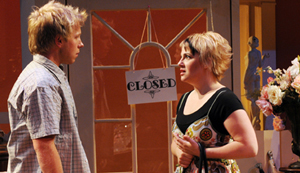 
ARTS IN REVIEW
Redundant to say, The Hit is a hit
By Carol Davis
 CORONADO, California—Mike Buckley, set designer of over 150 LPT productions since 1984, lighting designer, props manager, actor, and playwright can now deepen his playwrighting credits an inch or two on the notches of his accomplishment belt, or add another to them with the advent of his ‘new’ (as in world premiere) play, The Hit currently in progress at Lamb’s Players Theatre here. CORONADO, California—Mike Buckley, set designer of over 150 LPT productions since 1984, lighting designer, props manager, actor, and playwright can now deepen his playwrighting credits an inch or two on the notches of his accomplishment belt, or add another to them with the advent of his ‘new’ (as in world premiere) play, The Hit currently in progress at Lamb’s Players Theatre here.
Looking more like a sit com, possibly ready for prime time (remember the 50’s when Sid Caesar, Mel Brooks, Neil Simon, Carl Reiner and Larry Gelbart, all cut from same Jewish humor cloth, sat around and wrote gag lines for TV shows popping up everywhere), The Hit tickled more than a few funny bones with the opening night audience as one zany event followed another. Who knows, maybe Buckley will be the next Neil Simon.
Let’s back up a bit though. Lamb’s Players Theatre was going to mount this play as part of next season’s lineup, but as in life, theatre has to go with the flow. For Lamb’s, the responsibilities of managing the Horton Grand Theatre in downtown San Diego and having a second space to mount long-running shows came along. So in addition to the tasks of operating the Coronado space along with the downtown location, changes in this season’s shows had to be made to accommodate their operations. Without hesitation, the powers that be said unequivocally, “Yes”! Instead of the regularly scheduled show Leaving Iowa, which will now be mounted in 2009, The Hit hit the ground running last week.
Again, if you can conjure up in your imaginations the silly, predictable, outrageously wild shenanigans of a Hit (as in I pay you to kill me) gone wrong, it happened in Buckley’s The Hit. It all takes place in an antique or memorabilia shop (scenic and props by Buckley) owned and operated by Steve and Susan (Chris Bresky and Cynthia Gerber), whose late mother had left it to them. Susan gets some bad news from her doctor that appears to be life threatening, but won’t share it with her brother Steve who is a math wiz and candidate for Stanford. Rather than deal with the prognosis and wait for further medical advice, Susan hires a Hit ‘man’ to knock her off. That way if the death is accidental rather than suicidal, Steve can collect a whole bunch of insurance money, which will help him through school.
Here’s the deal. Susan doesn’t want to know when it’s coming or how it’s to be done! She hires a ‘Hit Man’ through, she thinks, the Russian mafia. She agrees to meet in the shop with a person named Samm, (Season Duffy) whom she thinks is Sam (Mike Buckley) the hit man. When the handsome Sam comes into the shop, at about the same time Samm enters, she sends Steve on an errand so he won’t overhear their conversation. Ignoring Samm, she converses with Sam on how the job is to be done.
Baffled, Sam tries to understand what Susan is talking about while nudging towards dating her. As a recent widower, he has not dated in six years. He is in San Francisco at a Travel Agent convention and the hotel’s concierge recommended her shop to him. Of course, she can’t think of getting involved with anyone since her life will soon be over. She gets blustery at every advance and rambles on about how he conducts business as a travel agent still thinking he’s the one who’s going to end her life. Thoroughly confused by all the misstatements, coy and double entendre conversation, Sam leaves befuddled. That’s when Samm approaches Susan and reveals her identity.
And so the ‘how’ and the ‘when’ of this about to happen act moves forward under Robert Smyth’s deft direction along with the help of some savory and unsavory characters showing up here and there, mistaken identities, quirky diversions and, of course a happy ending. Needless to say, havoc is thy name and red herrings, thy game as the play unfolds.
Let’s start with Samm. Samm is the petite, blond, rather absent minded (or is she) novice killer sent by her uncle Slavo (David Cochran Heath) to do the job and get experience. Let’s see; she attended Northwestern as a Sociology major, she seems to be an expert on African Art, she attended Pepperdine, did a stint at school in England, her drink of choice is a Big Gulp rather than tea, she’s bi-polar and looks to be about nineteen. Duffy is ideal as Samm. She’s on top of her game, perky, sly, delightful and convincing. Oh, one last thing, Steve is smitten with her. And Steve, he’s oblivious to everything going on about him except for Samm. Bresky’s Steve is as believable and easy as he is adorable and charming.
Both Susan and Sam are predictably the ideal couple, handsome, good natured and ready to engage in a serious relationship if Susan wasn’t so absorbed in her own plot to do away with herself. Cynthia Gerber’s timing is on target and her character is as eccentric as it is almost believable. Buckley chimes in when needed and has a few good laughs on his character as well.
But the real fun comes in with the ‘extras’. Here, Paul Maley and Gail West are a hoot and howl as they take on the identities of no less than a dozen different characters. Maley, whom I remember so vividly as the Private Eye/Narrator in Lamb’s production of The Boy Who Fell Into a Book is outrageously funny in every character he assumes, he just has that kind of face, stance and look. And while Jeanne Reith’s costumes are perfect, there is no denying Maley’s presence when he comes on the scene as either the shifty customer or the squabbling old man or ‘Smitty’. When he comes through the door of the shop that’s the signal we were in for a rollicking good laugh.
Ms. West and David Cochran Heath fill in the blanks as more assorted looky loos and Uncle Slavo. He reminded me of the character in Larry Shue’s The Foreigner when Slavo (Cochran Heath) was jabbering (and seriously at that) in what was meant to be Russian, but sounded more like gobly goop, and all of his cohorts knew what he was saying, including his niece Samm who carries on a conversation with him in the same vowel deprived language. All of this leads up to one madcap episode after another, with a series of calamitous situations that follow. All of this brings the house down, and finally rescues the main characters so they can live happily ever after.
If it all sounds nutty, and some of it is, Buckley can be proud of director Smyth and his steady cast of seven who made this summertime replacement, a night of fun and levity.
The Hit, Lamb’s Players Theatres 40th world premiere will play through July 13 at the Coronado location. On July 2nd, the theatre will produce the open-ended production of their well-received Boomers, the musical revue of a generation at The Horton Grand downtown in the Gaslamp Quarter.
For more information visit www.lambsplayers.org.
See you at the theatre.
Mind over matter: The Alesha Thomas story
By Alexa Katz
Alesha Thomas is not your normal teenager, and I am not referring to the braces that she has to walk with due to her cerebral palsy or the fact that she had had six surgeries in the last 12 years. Rather I am referring to the way she presents herself, the way she speaks, and most of all the way she knew what her dreams are.
When the SDJA’s AP biology classes went to the Salk Institute in March for AP Biology to hear a program put on by the March of Dimes Foundation about birth defects from Salk Institute scientists, we never expected that a 17-year-old with cerebral palsy would enrapture us. From the first syllable she uttered we were immediately lifted out of the trance that was brought on by over-our-head science. Her voice was clear, but with a slight quiver that gave it a unique tone and an unexpected authority that made almost every person in the audience immediately snap to attention.
However, it was not only the way she spoke, but what she had to say. The Point Loma High School senior talked about what it was like to have cerebral palsy and how even the smallest, most mundane tasks like getting dressed before school can prove to be a tiring ordeal. She spoke about how she plays wheelchair basketball and he intense physical therapy she has had to endure for most of her life. She was funny, charming, interesting and personable and had a rare knack for public speaking.
When asked about her plans for the future, she didn’t hesitate like most high schoolers or give the normal “I don’t know.” She instantaneously stated that she wanted to go to her “dream school,” the all girls Scripps College in the Claremont Consortium, and become a pediatrician. This is really what made Alesha so amazing. Whereas many of my fellow classmates and I struggle with our futures and can’t quite answer the questions of “Where do you want to go to college?” “What do you want to major in?” and “What career do you want?” she knew exactly the path she wanted to take. Furthermore, she was going to do it despite the fact that her body would resist her mind the entire time. She was as close to invincible as humanly possible.
Her determination and persistence were as contagious as her attitude. She took lemons and not only made lemonade for herself, but for everyone in the entire lecture hall, Nobel prize winners to struggling biology students. She made us want to have the courage to commit to a dream as well and to stop floundering because of self-doubt, or pure apathy. By the end of her presentation, the braces on her arms and legs which first caught our attention and the main point of the presentation were invisible.
Have you ever heard the phrase “Bad things happen to good people?” Alesha epitomized this when her application without application was rejected by Scripps College. I am not a college expert but I can’t figure out why. She had a 4.0 average, took two Advanced Placement courses her senior year, worked at Rady Children’s Hospital playing with kids with cancer (she even had a few conversations with SDJA’s own Matthew Beaver), participated in wheelchair sports, went to a conference held by the Claremont Colleges, and was accepted into UCSD which is no easy feat. On the Scripps website and in the Scripps brochure it keeps referring to strong women. They might have been referring to physical strength because I don’t know of anyone that embodies what it means to be a strong woman as much as Alesha does. Her rejection was an injustice of the worst type.
However, although I feel horrible for Alesha, there is a part of me that feels worse for Scripps College. Whereas Alesha will thrive in any environment, I sincerely believe that this decision will come back to haunt this university.
Maestro and the Diva at JCC
By Charly Jaffe
I peered around the audience as I took my seat and the lights began to dim at the Afula band and chorus concert on March 30. It was a full house, and like many JCC events, the audience was full of active Jewish senior citizens and families with young children. I wondered if it was humanly possible for all of us to be entertained. Surprisingly enough, we were. What the band lacked in excitement the adorable Russian conductor made up in charisma. And the chorus could have given American Idol a run for its money. The entire chorus was extremely talented, but there were two standouts; oer the top, Montana wannabe ‘Diva’ and more homely, but ‘OHMYG-D’ talented ‘Beltin’ Redhead.”
I may not be the most seasoned symphony critic, but here is what I do know. I have been to many a symphony and have been entertained by the music. This time, I was not entertained by the music. But, thankfully, I had my new best friend, the conductor, to look forward to at the end of each song. I was smitten even before he spoke a word. Wearing a suit and bowtie, the Conductor was a Mikhail Baryshnikov, AKA Alecsander Petrovsky from Sex and the City look alike. But once he opened his mouth, I was done for. Telling story after hilarious story in his Russian accent, the Conductor made a boring symphony fun, engaging the audience and using his humor and charisma to his advantage. If only the breaks between his anecdotes were a little bit shorter, I would have been much more pleased.
After seeing the band perform its first few numbers, my expectations were pretty low for the chorus. But I received the shock of the night when they opened their mouths. Every person in the chorus had at least a small solo, and every solo blew me away. The vocal talent was off the charts; their stage presence wasn’t quite as amazing. But I hardly even noticed due to my utter amazement at the caliber of their voices. The most outstanding voice was, without a doubt, Beltin’ Redhead. She was the first to sing and held the most solos—with good reason. With tubes like those I could easily be listening to her on the radio or onstage of a Broadway show.
But while Beltin’ Redhead was impressive, Diva stole the show. Diva’s voice was decent, but her performance was over the top, dramatic to the point of ridiculous. And that is exactly what made it so entertaining. While everyone was singing together, weight balanced, both hands on the mike, Diva had her head swung back, eyes closed, body rocking, and arms flailing with the music. Never one for conformity, Diva did anything he had to do to stand out, even took their matching outfits dress code to the edge. If she was going t have to wear boring khakis, she would make them skin tight. And if she had to wear white, green and yellow, screw pants with layered shirts! Diva had leggings, short shorts, a skin tight T-shirt, mesh shawl, and jacket tied around her shoulder. I mentioned to numerous people that I had nicknamed a singer Diva; and each and every person immediately knew exactly who I was talking about.
The Russian conductor easily took the cake for star of the symphony but it was a tough fight among the talented choir for spotlight. And when I say tough, I mean for everyone but Diva. Yes, Beltin’ Redhead has an astounding amount of talent, but performance wise there is no competition. The two stars of the show were clear—Diva and the Conductor.
SDJA role in Afula concert
By Eitan Frysh
Israeli influence on all Jews’ lives was displayed Sunday, March 30, at the Garfield Theater at the Lawrence Family JCC. The people interviewed that night, as a part of the Israel@60 celebration, including a performance by the Afula conservatory’s symphonic band and choir, provided glimpses into Israel’s past, present and future.
Interviewed speakers represented three generations of involvement with Israel. Longtime Jewish newspaper columnist Gert Thaler, interviewed by Norman Greene, told of her first visit to Israel and the role she played in developing a corps of travel agents packaging tours from San Diego to Israel. Dr. Richard Katz, interviewed by San Diego Jewish Academy journalism teacher Donald H. Harrison, told how being appointed aboard a Navy ship to arrange Chanukah services, led to a lifelong involvement in Jewish affairs, including serving as chairman of the national executive committee of the American Israel Public Affairs Committee (AIPAC)
SDJA Senior Charly Jaffe was interviewed by junior Gaby Maio. She told the audience of her plan next year to serve as an English teacher in Sha’ar Hanegev, the partnership region of the United Jewish Federation of San Diego. The idea of her supporting Israel in such a direct way indicated the continuing positive relationship between Israel and young American Jews.

 Editor's Note: We continue our presentation of the songs of Hal Wingard, moving this week to songs he wrote on the themes of fortunes. Here is a link to an index of Wingard's songs published by San Diego Jewish World. To hear Hal performing the song, click on its title. Editor's Note: We continue our presentation of the songs of Hal Wingard, moving this week to songs he wrote on the themes of fortunes. Here is a link to an index of Wingard's songs published by San Diego Jewish World. To hear Hal performing the song, click on its title.
#9, Getting Rich
From the time that they are babies
'Til they reach to ninety-two
There's a plan that certain ladies have,
A thing they've got to do.
It burns into their psyches,
The base of ev'ry dream:
To marry into money--
A consuming get-rich scheme.
To marry into money--
A consuming get-rich scheme.
But, then there are those others--
Perhaps they're just a few--
Who care not what a man has got,
Just that his heart be true.
The treasure they are seeking
Isn't money, it's the man.
And that's the kind of person
I will marry if I can.
And that's the kind of person
I will marry if I can.
# 26 Gypsy
Gypsy, my palm is open to you.
Gypsy, tell me what I need to do.
You have the vision
To make my decision.
My future is hanging on you
My life will shatter.
My loved-ones will scatter.
So help me to know what to do.
Gypsy, tell what the tarot cards say.
Gypsy, help me to unwind my way.
You have the power
In this crucial hour.
So what is my future, please say!
I feel so dismal.
My life is abysmal
Until you can show me the way.
Gypsy, what through the crystal is seen?
Gypsy, what does the crystal glow mean?
I need to know now.
I need you to show how
You read all the signs you have seen.
I can't keep waiting,
My patience abating.
So, tell me what does this all mean?
Well, sir, your palm, it is open to me.
But, sir, upon it there's no gold to see.
The crystal's quite sunny,
But I see no money;
And visions will never show free.
There's no need for fearing
Your future's appearing
As soon as your dollars I see.
Gypsy, I see you won’t do what you do
Unless I can open my checkbook for view.
So just keep your vision
I’ve made my decision:
My future will come without you.
#33, You've Taken What I Had
You, you make me feel so sad,
'Cause you've taken all the love that I had--
Taken all the love that I had,
Taken all the love that I had,
Taken all the love that I had.
You, you treated me so bad,
'Cause you've taken more than love, that I had--
Taken more than love that I had,
Taken more than love that I had,
Taken more than love that I had.
You, you make me feel so mad,
'Cause you've taken all the money I had--
Taken all the money I had,
Taken all the money I had,
Taken all the money I had.
Taken all the love that I had,
Taken more than love that I had,
Taken all the money I had.


ADVENTURES IN SAN DIEGO JEWISH HISTORY
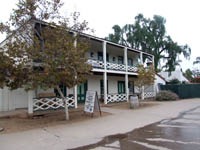
Robinson-Rose House
|

Old Temple Beth Israel |

Lawrence Family JCC |
Editor's Note: We are reprinting news articles that appeared in back issues of various San Diego Jewish newspapers. You may access an index of the headlines of those articles by clicking here. You may also use the Google search program on our home page or on the headline index page to search for keywords or names.
Jewish Labor Committee
From Southwestern Jewish Press, March 13, 1947
On Sunday evening, March 23rd, at 7:30 P.M., the Jewish Labor Committee will be hosts at an evening of entertainment including a musicale and guests speakers at the Beth Jacob Center, 3206 Myrtle Street.
The young and courageous fighter, the legendary heroine of the Warsaw Ghetto, Vladke, will speak of her experiences during the bloody years of the Nazi reign. She will tell about the description defying unbreakable strength that the Jewish masses, both young and old, showed during the entire Nazi occupation. Vladke, herself, is famous for her work during the war; the way she literally snatched Jewish children from the jaws of death and hid them in Gentile homes; smuggled bombs and dynamite over the Ghetto walls and did many other heroic things.
For the musical part of the program, Mr. Picaizen, the outstanding violinist, accompanied by Marie Stolurow at the piano, will play.
Mr. Benjamin Levine, of Los Angeles, Pacific Coast Executive Secretary of the Jewish Labor Committee, will also be a guest that evening. Refreshments will be served.
The Jewish Labor Committee invites the entire community to avail themselves of the opportunity to hear Vladke’s story.
{2008 Editor’s note: Vladke appears to have been Vladke Meed}
Young Actors Win Laurels in Play
From Southwestern Jewish Press, March 13, 1947, page 7
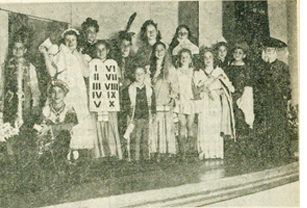 Both comedy and tragedy were featured in the Purim play presented by the children of the Tifereth Israel religious school last Sunday evening. A large audience of parents and friends applauded the courage of Queen Esther played by Pauline Glazer and of Mordecai (in real life, Danny Schaffer). Able Glazer as Haman was a convincing villain and Danny Blane as King Ahasuerus won much respect for his dignity and justice. Both comedy and tragedy were featured in the Purim play presented by the children of the Tifereth Israel religious school last Sunday evening. A large audience of parents and friends applauded the courage of Queen Esther played by Pauline Glazer and of Mordecai (in real life, Danny Schaffer). Able Glazer as Haman was a convincing villain and Danny Blane as King Ahasuerus won much respect for his dignity and justice.
Other young performers, pictured {at left}, were Hannah Rosen who played the role of the deposed Queen Vashti; Jackie Silvera and Moshe Rosen as two conspirators; Joan Borenstein as Zeresh; Allan Silvera, Gordon and Bernard Stollzoff, chamberlains; Irving Silvera, who won laughs as the jester; Fred Charles, Sanford Borenstein, officers; and Kay Prager and Charlene Zemen, beautiful maidens.
The evening was completed with gifts presented to the actors by the Daughters of Israel.
Drama, Prizes and Noisemakers at Party
From Southwestern Jewish Press, March 13, 1947, page 7
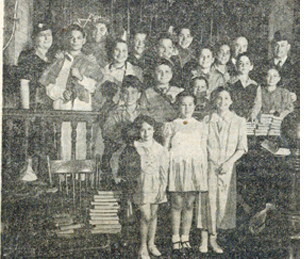 Prizewinners of the Temple Beth Israel Purim Costume party and the characters they depicted were as follows, reading left to right—kneeling: Stanton Camiel, a prince. First row: Ralph Sherman, the Megillah; Linda Solof, Rebecca; Jean Goldstein; The Ten Commandments; Lawrence Addleson, a Rabbi; Lois Kaufman, Arabian princess; Susan Solof, Mordecai’s wife; Linda Douglas, Queen Esther; Joel Mogy, who was elected junior Purim King; Norman Silverman, Haman. Second row: Mrs. Lorena Wellington, fourth grade teacher; Herbert Dembo, a king; Joyce Turner, who was elected Purim Queen; Jerry Miller, who was elected Purim King; and Jane Cohn, who was elected junior Purim Queen. Prizewinners of the Temple Beth Israel Purim Costume party and the characters they depicted were as follows, reading left to right—kneeling: Stanton Camiel, a prince. First row: Ralph Sherman, the Megillah; Linda Solof, Rebecca; Jean Goldstein; The Ten Commandments; Lawrence Addleson, a Rabbi; Lois Kaufman, Arabian princess; Susan Solof, Mordecai’s wife; Linda Douglas, Queen Esther; Joel Mogy, who was elected junior Purim King; Norman Silverman, Haman. Second row: Mrs. Lorena Wellington, fourth grade teacher; Herbert Dembo, a king; Joyce Turner, who was elected Purim Queen; Jerry Miller, who was elected Purim King; and Jane Cohn, who was elected junior Purim Queen.
Temple Beth Israel Purim Play-Party
From Southwestern Jewish Press, March 13, 1947, page 8
Queen Esther was never lovelier, King Ahasuerus never more kindly, nor Haman never more evil than at the Purim party held by the Temple Beth Israel Sunday School last Sunday morning.
Featured event of the party was a play given by the Beth Israel Dram Club. Outstanding performances in “The trial of Haman” were given by Donald Solomon, Harvey Levitt, Len Kleinman, Beverly Marsh, and Linda Solof. Florence Krasner, who took her role at the last moment, as a replacement, was especially fine in the part of the little girl who didn’t want to be Haman. The large assembly of parents and children who watched the performance all agreed that the play was a great success.
Gaily clad children, their costume depicting biblical characters, paraded across the stage after the play, and prizes were awarded by the board of judges to those wearing the most original and unusual costumes. Winners are pictures above long with the crowned kings and queen of the party.
The party ended with a barrage of noise from the gragers distributed to all young people of the party, and with a light luncheon provided by the Temple Sisterhood.
{Return to top}

Nancy Harrison
cruise & tour specialist
(619) 265-0808

SAN DIEGO JEWISH WORLD THE WEEK IN REVIEW
Australia
The Jews Down Under—a roundup of Australian Jewish news by Garry Fabian
—Israeli Minister Avi Dichter cancels visit
—Australian football legend backs peace team
—Shule merger Vote postponed
—Churches split with Jewish community over Palestine
—Amnesty out of its depth on report
—Australian wins My Israel Quiz
—Violent attack on Jewish teenagers in Perth
—Events galore in Canberra
San Diego
Stories from SDJA Student Quarterly:
—Passover in Promised Land by Gaby Maio
—Poway hate crime by Andrew Retzer
—Teens hone leadership skills at Jenna Druck confab by Alexa Katz
San Diego Jewish Trivia: Performers by Evelyn Kooperman
Adventures in San Diego Jewish History
—March 13, 1947: J.W.V. Aux President To Visit San Diego
—March 13, 1947: Zionist Group Plans Dinner
—March 13, 1947:450 Attend BB Youth Rally
The Arts
Shel Silverstein play: A cavalcade of crazies; play review by Cynthia Citron
Grief may lead to personal transformation; book review by Donald H. Harrison in San Diego
Middle East
Middle East theme song: Send in the Clowns? by Ira Sharkansky in Jerusalem
It's SRO for Shavuot in Old Jerusalem by Judy Lash Balint in Jerusalem
How kibbutz celebrates agricultural holiday by Ulla Hadar in Kibbutz Ruhama. Israel
San Diego
Block's win and long-range Nunez plans by Gary Rotto in San Diego
SDJA juniors scout prospective colleges by Brenna Decker, Michele Goldfarb-Shapiro, Becky Rudin and Asher Wittenberg from up and down the U.S. West Coast
Smarter than a 5th grader? I'd have to work myself through 1st grade competion first by Donald H. Harrison in San Diego
Adventures in San Diego Jewish History
—March 13, 1947:Form Community Relations Advisory Committee Here
—March 13, 1947: Crum Demands 100,000 Enter Palestine—Print Mufti Papers
—March 13, 1947: S.O.S. Passover Needs in Europe
Arts & Leisure
The emperor is even worse than naked by Sheila Orysiek in San Diego
Frieda's big surprise at Frida's Restaurant by Donald H. Harrison in Chula Vista, California
Play tackles nature of American Judaism by Cynthia Citron in Los Angeles
San Diego County
Three articles from SDJA Student Quarterly, a student publication of San Diego Jewish Academy:
—Across the Editor's Desk by Alexa Katz
—SDJA 'Spring Fling' went under water by Michelle Rizzi
—Fellowship to Jack deTar by Gaby Maio
Adventures in San Diego Jewish HistoryMiddle East
Hamas acknowledges its responsibility for rocket attacks that killed 26 Israelis by Ira Sharkansky in Jerusalem
To the Israeli government: Do something! by Yankele Cohen in Kibbutz Nahal Oz, Israel
Judaism
Continual study: too much of a good thing? by Rabbi Leonard Rosenthal in San Diego
Trusting in Hashem at Bear Stearns by Robert Savit via Rabbi Baruch Lederman in San Diego
San Diego County
Green collective for Jewish institutions? by Marissa Palin in San Diego
Three articles from SDJA Student Quarterly, a student publication of San Diego Jewish Academy:
—Seniors leave big shoes for juniors to fill by Gaby Maio
—Pickets target SDJA by Eitan Frysh
—New programs in SDJA ASBC by Shiri Bogomolny
Arts & Leisure
The Schwartzes within The Brady Bunch by Cynthia Citron in Hollywood, California
Sports theme at San Diego County Fair by Donald H. Harrison in Del Mar, California
Adventures in San Diego Jewish History
—March 6, 1947: Western States Meet; Here This Weekend
—March 6, 1947: Beth Jacob to Have New Rabbi
—March 27, 1947: Wins Akiba Award
Middle East
Weighing Obama and McCain from an Israeli perspective, each has drawbacks by Ira Sharkansky in Jerusalem
UK academic boycott of Israel resurfaces by Lloyd Levy in London
Canada
New Yorker brings California-style Jewish healing service to Anglophone Toronto by Rabbi Dow Marmur in Toronto
San Diego
Three commentaries from SDJA Student Quarterly, a student publication of San Diego Jewish Academy:
—Taking the SAT: The best four hours I ever spent trying to gouge out my eyes with a pen by Micah Frank
—CA court advances march to equality by Harry Doshay
—Iran's deadly bias against gays by Sarah Abelsohn
The Arts
Chapter Eleven of Reluctant Martyr, a serialized novel by Sheila Orysiek of San Diego
When octogenarian father and 40ish son both are single, who gives dating advice? Book review by Donald H. Harrison in San Diego
Programme Request? Take A Number by Carol Davis in San Diego
Adventures in San Diego Jewish History
—March 27, 1947: U.J.F. Off To Flying Start: San Diego Aware of Unprecedented Need in 1947—Geared to Meet It
—March 27, 1947: Editorial Page: Hope, Faith and Charity
—March 27, 1947: We were there by Albert Hutler
Link to previous editions
< BACK TO TOP
|
|

